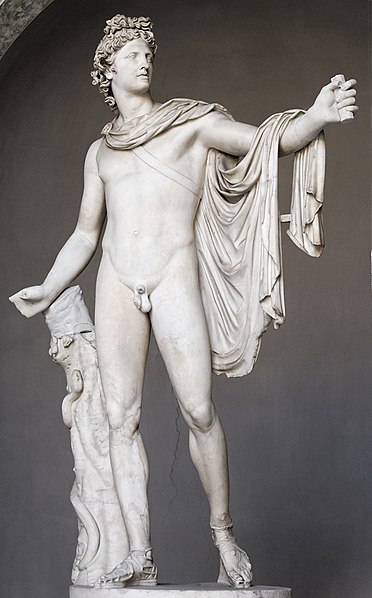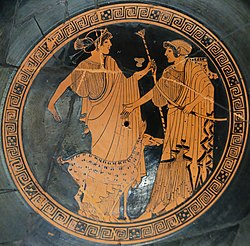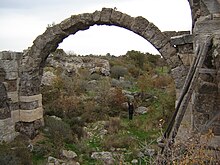|
Greek city of
Alexandria Troas
in
Troas
Bronze Quarter Unit 10mm (0.71 grams) Struck 302/301 B.C.
Reference: Bellinger A31 var.; cf. SNG Copenhagen 83-6
Laureate head of Apollo right.
AΛE, Horse standing grazing right.
A coastal city situated
south-west of Ilion, it was founded circa 310 B.C. by Antigonos and originally
bore the name Antigoneia. A decade later Lysimachos renamed the place
Alexandreia.
You are bidding on the exact item pictured,
provided with a Certificate of Authenticity and Lifetime Guarantee of
Authenticity.

Apollo Belvedere
,
ca. 120–140 CE
Apollo is one of the most important and complex of the
Olympian deities
in
ancient Greek
and
Roman religion
,
Greek
and
Roman mythology
, and
Greco
–Roman
Neopaganism
. The ideal of the
kouros
(a beardless, athletic youth),
Apollo has been variously recognized as a god of light and the sun, truth and
prophecy, healing, plague, music, poetry, and more. Apollo is the son of
Zeus and Leto
, and has a twin sister, the chaste
huntress Artemis
. Apollo is known in Greek-influenced
Etruscan mythology
as Apulu.
As the patron of Delphi
(Pythian Apollo), Apollo was an
oracular
god—the prophetic deity of the
Delphic Oracle
. Medicine and healing are
associated with Apollo, whether through the god himself or mediated through his
son Asclepius
, yet Apollo was also seen as a god
who could bring ill-health and deadly
plague
. Amongst the god’s custodial charges,
Apollo became associated with dominion over
colonists
, and as the patron defender of herds
and flocks. As the leader of the
Muses (Apollon Musegetes) and director of their choir, Apollo
functioned as the patron god of music and poetry.
Hermes
created the
lyre for him, and the instrument became a common
attribute of Apollo
. Hymns sung to Apollo were
called paeans
.

Apollo (left) and
Artemis
.
Brygos
(potter signed), Tondo of an
Attic red-figure cup c. 470 BC,
Musée du Louvre
.
In Hellenistic times, especially during the 3rd century BCE, as Apollo
Helios he became identified among Greeks with
Helios
,
Titan
god of the sun
, and his sister Artemis
similarly equated with
Selene
, Titan
goddess of the moon
In Latin texts, on the
other hand,
Joseph Fontenrose
declared himself unable to
find any conflation of Apollo with
Sol
among the
Augustan poets
of the 1st century, not even in
the conjurations of Aeneas
and
Latinus
in
Aeneid
XII (161–215). Apollo and Helios/Sol
remained separate beings in literary and mythological texts until the 3rd
century CE.
Origins

The Omphalos
in the Museum of
Delphi
.
The cult centers of Apollo in Greece,
Delphi
and
Delos
, date from the 8th century BCE. The Delos
sanctuary was primarily dedicated to
Artemis
, Apollo’s twin sister. At Delphi,
Apollo was venerated as the slayer of
Pytho
. For the Greeks, Apollo was all the Gods
in one and through the centuries he acquired different functions which could
originate from different gods. In
archaic Greece
he was the
prophet
, the oracular god who in older times
was connected with “healing”. In
classical Greece
he was the god of light and of
music, but in popular religion he had a strong function to keep away evil.
From his eastern-origin Apollo brought the art of inspection from “symbols
and omina
” (σημεία και τέρατα : semeia kai
terata), and of the observation of the
omens of the days. The inspiration oracular-cult was probably
introduced from Anatolia
. The
ritualism
belonged to Apollo from the
beginning. The Greeks created the
legalism
, the supervision of the orders of the
gods, and the demand for moderation and harmony. Apollo became the god of
shining youth, the protector of music, spiritual-life, moderation and
perceptible order. The improvement of the old
Anatolian
god, and his elevation to an
intellectual sphere, may be considered an achievement of the
Greek
people.
Healer and
god-protector from evil
The function of Apollo as a “healer” is connected with
Paean
, the physician of the Gods in the
Iliad
, who seems to come from a more
primitive religion. Paeοn is probably connected with the
Mycenean
Pa-ja-wo, but the etymology is the
only evidence. He did not have a separate cult, but he was the personification
of the holy magic-song sung by the magicians that was supposed to cure disease.
Later the Greeks knew the original meaning of the relevant song “paean”. The
magicians were also called “seer-doctors”, and they used an ecstatic prophetic
art which was used exactly by the god Apollo at the oracles.
In the Iliad, Apollo is the healer under the gods, but he is also the
bringer of disease and death with his arrows, similar to the function of the
terrible
Vedic
god of disease
Rudra
.He sends a terrible plague to the
Achaeans
. The god who sends a disease can also
prevent from it, therefore when it stops they make a purifying ceremony and
offer him an “hecatomb” to ward off evil. When the oath of his priest appeases,
they pray and with a song they call their own god, the beautiful Paean.
Some common epithets of Apollo as a healer are “paion” , “epikourios”, “oulios”,
and “loimios” . In classical times, his strong function in popular religion was
to keep away evil, and was therefore called “apotropaios” and “alexikakos” ,
throw away the evil).
In later writers, the word, usually spelled “Paean”, becomes a
mere epithet of Apollo in his capacity as a god of
healing
.
Homer illustrated Paeon the god, and the song both of
apotropaic
thanksgiving or triumph. Such songs
were originally addressed to Apollo, and afterwards to other gods: to
Dionysus
, to Apollo
Helios
, to Apollo’s son
Asclepius
the healer. About the 4th century
BCE, the paean became merely a formula of adulation; its object was either to
implore protection against disease and misfortune, or to offer thanks after such
protection had been rendered. It was in this way that Apollo had become
recognised as the god of music. Apollo’s role as the slayer of the
Python
led to his association with battle and
victory; hence it became the
Roman
custom for a paean to be sung by an army
on the march and before entering into battle, when a fleet left the harbour, and
also after a victory had been won.
Oracular cult

Columns of the
Temple of Apollo
at Delphi, Greece.
Unusually among the Olympic deities, Apollo had two cult sites that had
widespread influence: Delos
and
Delphi
. In cult practice,
Delian Apollo
and
Pythian Apollo
(the Apollo of Delphi) were so
distinct that they might both have shrines in the same locality.Apollo’s
cult
was already fully established when written
sources commenced, about 650 BCE. Apollo became extremely important to the Greek
world as an oracular deity in the
archaic period
, and the frequency of
theophoric names
such as Apollodorus or
Apollonios and cities named Apollonia testify to his popularity.
Oracular sanctuaries to Apollo were established in other sites. In the 2nd and
3rd century CE, those at
Didyma
and
Clarus
pronounced the so-called “theological
oracles”, in which Apollo confirms that all deities are aspects or servants of
an
all-encompassing, highest deity
. “In the 3rd
century, Apollo fell silent.
Julian the Apostate
(359 – 61) tried to revive
the Delphic oracle, but failed
Alexandria Troas (“Alexandria of the
Troad
“, modern
Turkish
: Eski
Stambul) is an ancient
Greek
city situated on the
Aegean Sea
near the northern tip of
Turkey
‘s western coast, a little south of
Tenedos
(modern
Bozcaada
). It is located in the modern Turkish
province of
Çanakkale
. The site sprawls over an estimated
400 hectares (1,000 acres); among the few structures still extant today are a
ruined bath and gymnasium complex and a recently uncovered stadium.

Aleaxandria Troas Therme
History
Hellenistic
According to Strabo
, this site was first called Sigeia;
around 306 BC
Antigonus
refounded the city as the
much-expanded Antigonia Troas by settling the people of five other towns
in Sigeia, including the once influential city of
Neandria
. Its name was changed by
Lysimachus
to Alexandria Troas, in memory of
Alexander III
of Macedon
(Pliny
merely states that the name changed from Antigonia to Alexandria). As the chief
port of north-west Asia Minor, the place prospered greatly in Roman times,
becoming a “free and autonomous city” as early as 188 BC,[3]
and the existing remains sufficiently attest its former importance. In its
heyday, the city may have had a population of about 100,000.
Strabo
mentions that a
Roman
colony
was created at the location in the reign
of Augustus
, named Colonia Alexandria Augusta
Troas (called simply Troas during this period). Augustus,
Hadrian
and the rich grammarian
Herodes Atticus
contributed greatly to its
embellishment; the aqueduct still preserved is due to the latter.
Constantine
considered making Troas the capital
of the Roman Empire
.
Roman
In Roman times, it was a significant port for travelling between
Anatolia
and Europe.
Paul
of Tarsus
sailed for Europe for the first time
from Alexandria Troas and returned there from Europe (it was there that the
episode of the raising of
Eutychus
later occurred).
Ignatius of Antioch
also paused at this city
before continuing to his martyrdom at Rome.
Byzantine
Several of its later
bishops
are known: Marinus in 325; Niconius in
344; Sylvanus at the beginning of the 5th century; Pionius in 451; Leo in 787;
Peter, friend of the
Patriarch Ignatius
, and adversary to Michael,
in the ninth century. In the 10th century Troas is given as a suffragan of
Cyzicus
and distinct from the famous
Troy (Heinrich
Gelzer, Ungedruckte … Texte der Notitiae episcopatuum, 552;
Georgii Cyprii descriptio orbis romani
,
64); it is not known when the city was destroyed and the diocese disappeared.
The city remains a
titular see
of the
Roman Catholic Church
, Troadensis; the
seat is vacant following the resignation of the last bishop in 1971.
Troas is also a titular see of the
Orthodox Church
under the
Ecumenical Patriarchate
. The most recent
hierarch, His Grace Bishop Savas (Zembillas) of Troas, served 2002-2011. He is
now
Metropolitan Savas (Zembillas) of Pittsburgh
in
the
Greek Orthodox Archdiocese of America
.
Ottoman
Karasid
Turkomans
settled in the area of the Troad in
the 14th century. Their
beylik
was conquered by the Ottomans in
1336. The ruins of Alexandria Troas came to be known among the Turks as Eski
Stambul, the “Old City”. The site’s stones were much plundered for building
material (for example
Mehmed IV
took columns to adorn his
Yeni Valide Mosque
in
Istanbul
). As of the mid-18th century the site
served as “a lurking place for bandetti”.
Modern
By 1911 the site had been overgrown with
vallonea oaks
and much plundered, but the
circuit of the old walls could still be traced, and in several places they were
fairly well preserved. They had a circumference of about ten kilometres, and
were fortified with towers at regular intervals. Remains of an ancient bath and
gymnasium complex can be found within this area; this building is locally known
as Bal Saray (Honey Palace) and was originally endowed by Herodes Atticus
in the year 135. Trajan
built an aqueduct which can still be
traced. The harbour had two large basins, now almost choked with sand. It is the
subject of a recent study by German archaeologists who are digging and surveying
at the site. Their excavation has uncovered the remains of a large stadium
dating to about 100 BC.
|












